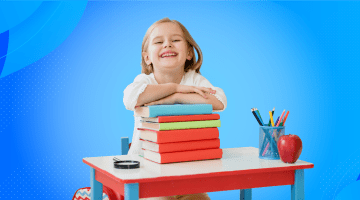Scaffolding in Education: How Scaffolding Helps
reviewed by Jo-ann Caballes
Updated on August 25, 2024
Have you ever tried teaching your child a new math concept? If you did, you know (or guess) how many challenges the whole learning process encapsulates. It’s not enough to teach a thing or reveal the topic — it’s vital to bind the new knowledge into what your child already knows, creating a system. It’s where scaffolding comes into play. But what is it? And how does it help build your child’s proficiency? Read on to discover.
What is scaffolding in education?
Scaffolding in teaching means building specific knowledge in a child by gradually removing teachers’ guidance. As kids become more competent in any topic, they should also be more independent — that’s what scaffolding manifests. Eventually, the teacher’s role comes down to explaining content, processes, and strategies and supporting kids, if needed.
However, scaffolding isn’t spontaneous. Instead, it requires careful analysis of prior knowledge a child already possesses. To conduct it, teachers commonly employ constant progress evaluation. This way, the tutor knows where they need to maintain their support and where it can be removed.
Now, let’s shift to our subject. In math, the scaffolding practice can involve the following:
- Pre-teaching appropriate math vocabulary
- Providing a working example
- Asking questions meant to guide a kid
- Giving a simple version of a problem before a more advanced example
- Dividing the learning process into more manageable pieces
Why is scaffolding important?
One of the critical benefits of scaffolding is that it creates a supportive environment where children can easily ask questions, provide feedback, and clarify anything that seems too complex.
This way, a tutor shifts from a class-dominant to a supportive element. And who’s the dominant now? Yes, it’s your child! With this approach, they are the center of learning, actively engaged in all activities, and encouraged to take the initiative.

The scaffolding technique is simply indispensable when a child is stuck with a specific topic and cannot move further. It’s when a professional tutor steps in to ask prompt questions and organize some activities to encourage their active participation.
However, the tutor should have enough experience and knowledge to guide the process correctly. Due to the complexity of the scaffolding technique, only a few teachers have successfully adopted it.
To discover how the scaffolding learning process works, let’s explore the things in an example.
Scaffolding in learning with Brighterly
Brighterly is an online tutoring platform that focuses on providing 1:1 math classes and building a highly personal approach. Its principles are to deliver tailored, result-driven tutoring centered around the needs of each specific child without cliches or redundancies.

Indeed, to reach these ambitious aims, the platform has to adopt advanced teaching strategies and train its personnel to manage all of them correctly. One of the approaches they commonly use is the scaffolding teaching strategy. Here’s a step-by-step example of how Brighterly can implement this technique for your child’s learning.
1. Building on previous knowledge
First, Brighterly tutors will test your kid’s previous knowledge on a topic. This step allows them to understand if there’s any knowledge basis to build on.
The results of the tests can differ — the kid can have a solid grasp of some previous topics or lack any understanding at all. To define the ground and build pre-topic knowledge, tutors usually employ the following:
- Vocabulary testing
- Mini-lessons
- Quick discussions
- Journal entries
As a result, they get a complete picture, with any weak or strong points to work with.
2. Presenting the problem
At this stage, Brighterly tutors start working on the very topic. First, they build the necessary basis, such as applicable vocabulary or related facts.
Tutors at the platform try to make their presentations as easy-to-understand and straightforward as possible. They use simple wording to explain the topic and try to bind it to what your kid already knows. It creates a system in their mind and shows the actual value of new material.
Here are some task examples of scaffolding in education Brighterly teachers would usually employ:
- Mind maps
- Graphs
- Math games
- Modeling
- Read-outs
3. Repeating
It’s when your kid will become active. At this stage, a Brighterly tutor will develop a sequence of different-level tasks to increase understanding. Here’s what they would usually use:
- The pause method means that the teacher pauses for a while in their explanation to ask your kid an open-ended question or encourage them to explain a concept.
- The think-share exercise involves giving a specific question and outlining some free time when your kid can think it out. Once the time expires, they must share their thoughts and ideas with the tutor.
- According to the red-yellow-green strategy, your kid will have corresponding cards of each color. As a lesson progresses, they must hold a specific card to reflect their understanding of the concepts discussed.
4. Checking the understanding
Now that your child has already grasped the concepts and practiced some simple tasks, it’s time to evaluate how well they understand the subject. Did they perfect everything? Brilliant! If not, the tutor will continue modeling their knowledge and return to more straightforward examples and problems.
But how do they know if your kid succeeded? At this stage, the child should be able to answer any given questions independently, as well as demonstrate their skills by explaining concepts and providing definitions.
Once Brighterly tutors see the progress, they withdraw a bit and prompt the child to participate in more autonomous work. The method called “I do, we do, you do” is the common practice during scaffolding lessons:
- I do stage takes place when tutors provide direct instruction on a topic. However, they don’t just explain but also regularly verify if the kid understands the topic. This is what was discussed in points 2 and 3.
- We do is when the tutor works collaboratively with your child to help them solve diverse tasks. It’s when both parties are the central participants. Tasks like graphic organizers and hands-on practices are commonly used at this stage.
- You do is that very stage when your child becomes completely independent. They are comfortable with the concept learned and have gained some hands-on experience, so the teacher knows they can now freely use what was studied.
5. Demonstration of the knowledge
Finally, the kid has to show what they’ve learned. But the stage is tricky, too: in a hurry, a tutor can move to it too soon, making them struggle too much with tasks. Conversely, they may conduct too much preparatory work, boring your child. Luckily, Brighterly teachers are skilled in maintaining the balance, so you don’t need to worry about the lesson flow.
Eventually, scaffolding teaching takes time to master but can bring great results by making your child the learning centerpiece. Interested in how the technique works in practice? Book the first demo lesson at Brighterly and let your kid experience all the benefits!
4 types of scaffolding in education
Scaffolding in teaching comes in four main types:
Of course, the type used will depend on the specificity of the subject and topic. However, it’s essential to know the nuances of each variation so that you can better tackle your kid’s progress and maybe implement some of them as an extra activity.
Sensory scaffolding
This type literally means using visual elements, manipulatives, and representations to facilitate learning. It targets several senses, so it helps to better understand and interpret applicable concepts. Here are some of the key components to know about:
- Manipulates and visual aids represent abstract ideas in a visual, easy-to-grasp form. For instance, when teaching math operations, you can use blocks or counters to allow kids to physically manipulate them and see how quantities are reduced or increased.
- Modeling is another method that involves the visual representation of a concept. It will show your kid a bigger picture and allow them to see how concept elements interact with one another.
Sensory scaffolding is exactly about facilitating your child’s sensory memory. And there’s no better way to achieve great results than with bright colors, unique shapes, and memorable textures. All these elements create meaningful relations and help better understand the interconnection.
Graphic scaffolding
Graphic examples of scaffolding in the classroom help children better draw relations between abstract components in a system. These can include mind maps, anchor charts, or graphic organizers. Let’s explore them in detail:
- Mind maps serve to represent system elements in an interconnected or hierarchical manner. They are among the best tools to organize concepts and clear out things.
- Anchor charts are typically drawn by kids themselves. They serve as a visual representation of the concepts explained. Once created, they become a powerful reference for independent work where all the critical information is stored.
- Graphic organizers are the best helpers at tackling complex topics. They encompass any diagram type, like Venn diagrams, concept maps, or flowcharts. They are ideally suited to categorize information and show some patterns.

The importance of scaffolding in education and using its graphic representations cannot be overestimated due to several reasons:
- It provides a better understanding of connections between elements and creates a clear system in mind.
- It has a robust attention-grabbing effect achieved through the visually appealing format.
- Analyzing, evaluating, and synthesizing information in graphic representations helps develop high-order thinking skills.
- These graphic representations are highly inclusive, so they can easily catch attention and entertain practically any learner.
Despite the many benefits of graphic scaffolding, it employs a lot of teacher work, too. Thus, tutors must pay enough attention to explaining how those graphical representations work and how elements are interconnected inside a system.
Interactive scaffolding
Interactive methods have proven to be effective in studying practically any topic. Through collaboration, kids can ask their questions or, conversely, explain the things they have a better grasp of.
Some tried and tested interactive practices are jigsaw groups, peer learning, and think-pair-share exercises. Sure, you’ll have to invite your child’s peers for these activities, but the result is truly worth the effort. Here are scaffolding in education examples:
- Jigsaw groups are composed of a few learners, each responsible for learning and teaching a specific lesson part. This technique gives excellent results because it allows for sharing responsibility and encourages intense teamwork.
- The peer learning approach is where children share their experiences and can explain the concepts they know best. It allows one to develop critical thinking, achieve a new perspective, and better understand the subject’s peculiarities.
- Think-pair-share exercises are pair activities in which kids have to complete intense pair work while discussing the problem. Once ready, they share their findings with everyone else present. This strategy does wonders for enhancing communication skills and learning to build more meaningful and productive dialogs.
Technological scaffolding
Technology is undividable in today’s lives, and so it is in modern learning. So, technological scaffolding employs any interactive platforms used for more productive learning. Quizzes, simulations, and interactive scaffolding lessons — all fit into the category.
Technology makes studying more dynamic and adaptive — it grabs your child’s attention and allows them to focus on the subject better. Most commonly, the example of scaffolding using the tech domain includes various online resources, like learning apps and interactive websites.
One more interesting example is adaptive platforms. These combine all of the category’s benefits. They can adjust to your child’s needs by analyzing their progress and providing tailored content and tasks. This way, your kid won’t have to rush. Instead, they will cover a topic at their own pace, paying extra attention to weaknesses and speeding up when their strong topic arises.

To highlight the potential of technology in education even more, let’s clarify the benefits of tech scaffolding:
- The personalized, adaptive learning plans ensure that your child studies what they need now. Plus, those platforms are pretty flexible, so your kid will remain the centerpiece of the whole process.
- Including tech elements boosts attention. Let’s be sincere: most kids are just crazy about technology these days. So, once you combine some tech with math, you’ll get an attraction potion they cannot resist.
- Technology is everywhere now. So, your kid will get unlimited access to math learning and practice. They can study anytime and anywhere they like, with no exceptions.
- Commonly, those smart apps or sites allow progress tracking. This way, you get a complete view of how well your child performs and what are their strong and weak areas.
How does scaffolding help students?
The main benefit of scaffolding for students is that it puts them in the center: they are encouraged to ask questions, share their knowledge, and provide feedback. At the same time, a tutor becomes more of a supportive element, ready to step in when some challenges occur.
This shifted approach brings many unconventional gains, including:
- Deeper student involvement achieved through the challenging nature of educational scaffolding.
- Constant participation in group discussions results in the development of math knowledge and better communication.
- Kids are taught how to learn, not just memorize a specific topic.
- Tighter accompanying of your child, along with tailored and personal instructions, make them more of participants, not observers.
- Finally, scaffolding creates a sharing environment where children know they have someone to rely on.
To conclude
Scaffolding learning has changed the game rules. Now, tutors are no longer at the center of a lesson, sharing their endless monologs and moralizing on the importance of the topic. Instead, kids virtually see WHY the topic is information and learn to utilize it immediately. And while scaffolding is no wonder, it really can bring up your child’s math learning to a new, more qualitative level.
Are you seeking a tutor who has mastered scaffolding? Well, some of the best ones flock at Brighterly. Why not book your lesson right away?














